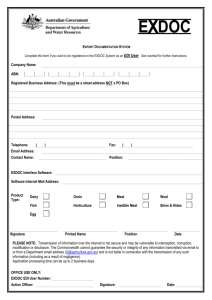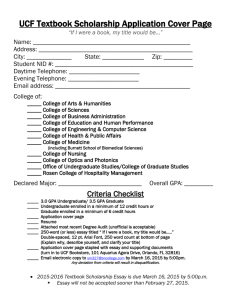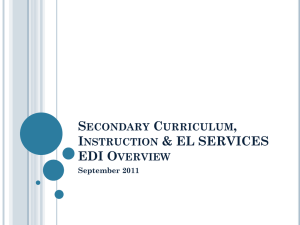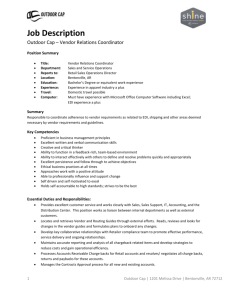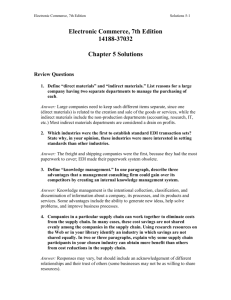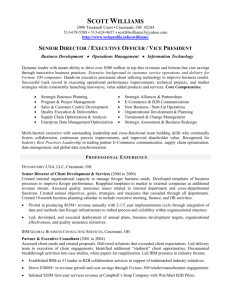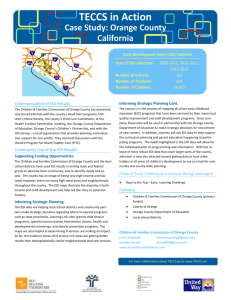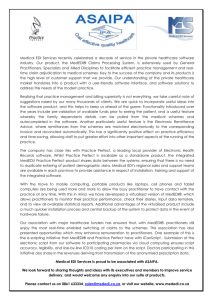The DMX EDI System - To parent directory or resource
advertisement
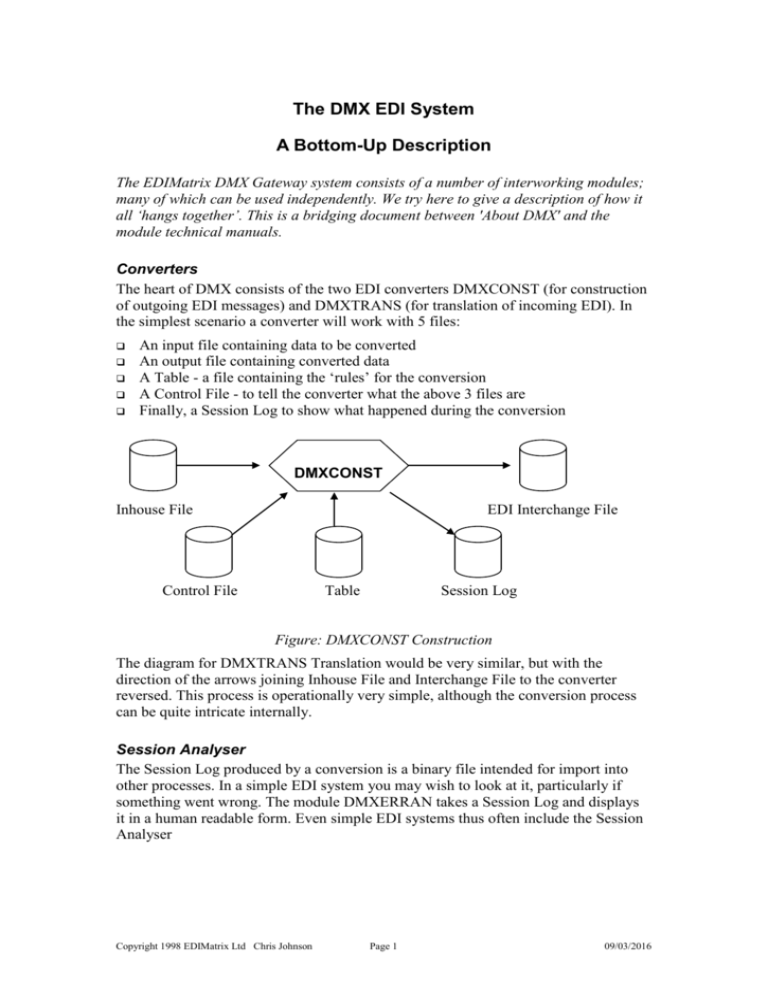
The DMX EDI System A Bottom-Up Description The EDIMatrix DMX Gateway system consists of a number of interworking modules; many of which can be used independently. We try here to give a description of how it all ‘hangs together’. This is a bridging document between 'About DMX' and the module technical manuals. Converters The heart of DMX consists of the two EDI converters DMXCONST (for construction of outgoing EDI messages) and DMXTRANS (for translation of incoming EDI). In the simplest scenario a converter will work with 5 files: An input file containing data to be converted An output file containing converted data A Table - a file containing the ‘rules’ for the conversion A Control File - to tell the converter what the above 3 files are Finally, a Session Log to show what happened during the conversion DMXCONST Inhouse File EDI Interchange File Control File Table Session Log Figure: DMXCONST Construction The diagram for DMXTRANS Translation would be very similar, but with the direction of the arrows joining Inhouse File and Interchange File to the converter reversed. This process is operationally very simple, although the conversion process can be quite intricate internally. Session Analyser The Session Log produced by a conversion is a binary file intended for import into other processes. In a simple EDI system you may wish to look at it, particularly if something went wrong. The module DMXERRAN takes a Session Log and displays it in a human readable form. Even simple EDI systems thus often include the Session Analyser Copyright 1998 EDIMatrix Ltd Chris Johnson Page 1 09/03/2016 DMXERRAN Session File Report Figure: DMXERRAN Session Analyser Traffic Analyser The information in the Session Logs gives a picture of what has happened with your EDI traffic, but it is a chronological list. To accumulate the information into a database which can then be accessed to provide summary information, and can be used by other modules in a DMX system, the logs are imported into the DMXGWAY Traffic Analyser to generate records in a number of tables in a standard Access database DMXGWAY Session Logs GateWay database Figure: DMXGWAY Update Function Network Modules EDI files can be transmitted over a wide variety of different networks. For each network a user normally has a Communication Program to handle network traffic; each with its own way of doing things. DMX interfaces to such Communication Programs by means of Network Modules; which use the information in the GateWay database to create command files (or their equivalent) for each network, initiate the Communication Program, and then analyse the results in order to update the status of messages in the database. The capabilities of each Network Module depend very much on the nature of the network, and Communication Program which is used. Commands DMXBTNET Comms DmxGway database Results Copyright 1998 EDIMatrix Ltd Chris Johnson Page 2 09/03/2016 Figure: DMXBTNET Network Module Communication Programs A variety of Communication Programs can be used. For several networks the DMXCOMMS engine, with a suitable script, provides the necessary asynchronous communication. An increasingly used alternative is one of the popular mail programs such as Microsoft Exchange. Script File(s) out Network DMXCOMMS File In Log Reports Figure: DMXCOMMS for BT EDI*NET Re-formatters The communication of data to and from a client application often takes place directly using the inhouse files for the converters using import/export routines particular to the application involved. Because of the wide variety of applications used EDIMatrix provides the DMXPRINT and DMXREFRM reformatters, which transform information between an inhouse file suitable for the converters and a very wide variety of single and multiple file formats which may be most convenient for an individual application. DMXREFRM takes input from multiple relational files, DMXPRINT from a tagged hierarchical file; both can output reports, hierarchical files, or multiple relational files. DMXREFRM Relational Input Files Inhouse File Figure: DMXREFRM example WinTasks We have given a very brief description of the individual components of a DMX EDI system, but there has to be a way of getting them all to hang together. In DMX this is achieved by using the WINTASKS Command Interpreter to process a Task, a file of commands resembling a DOS batch file. This approach, combined with the versatility Copyright 1998 EDIMatrix Ltd Chris Johnson Page 3 09/03/2016 of the component modules, allows us to generate EDI systems that are adapted to the needs of the client. An example of a WinTask follows: CD C:\DMX Change drive and directory IFNOTEXIST test.inh GOTO NETWORK Any data to construct? bin\dmxconst X400c.ctl Run construction bin\dmxgway U Import session log into GateWay database :NETWORK bin\dmx400ap ECI Run Network Module IFEXIST inputich/*.ipm GOTO OK2 Any data received? SAY 5 Nothing received from X400 EXIT :OK2 bin\dmxtrans X400t.ctl Run translation (-1) bin\dmxgway U Import session log into GateWay database EXIT Scheduling The most usual way of running an EDI System is to activate it at intervals to deal with anything that may have accumulated since it was last run. DMXWCRON is the user interface to the DMX Scheduler, which is typically used to activate one or more WinTasks periodically to perform the EDI processing. The DMX scheduler takes minimal system resources, and is ‘easier’ to use than most other scheduling systems. It consists of a tiny resident process called DMXALARM, the user interface DMXWCRON used to set up the schedules, and the ‘invisible’ program DMXDEMON which is called by both to do the actual work of analysing schedules and dispatching programs. This concludes our first pass over the DMX EDI system. We shall now look at the components in more detail, since we have ignored all but the most basic capabilities so far. Second Time Around! Converters Profiles One major feature of the converters which we have not previously looked at is their ability to handle a wide variety of different messages and different trading partners in a single session. This is achieved by using the combination of partner and/or message type to steer which control file records are read to determine the operational environment of conversion. The specification of partners, messages, and control records is called a Profile, and is a functional description of your EDI processing for outgoing, or incoming information. This is particularly useful for incoming information, where you may well receive files from the network containing interchanges from several partners, each enclosing a mixture of different types of messages. Copyright 1998 EDIMatrix Ltd Chris Johnson Page 4 09/03/2016 This is an example of a profile which might be used when you receive orders and order change messages from all your partners (who can thus be treated as a ‘default partner’) and in addition credit advice messages from T.Atkins Ltd. First define the nickname and network address for T. Atkins Ltd PARTNER “T_Atkins” “5146230000008” “” Then indicate that the ‘Credits’ document handling is defined locally in the profile MESSAGE “Credits” “CREADV:” “@credits” Tell the converter which output file and Table to use @INHF creditav.inh @TABL creadv.dmt Finally say that any messages from Atkins other than CREADV are handled normally USE DEFAULT Define the Default Partner i.e. everyone except Atkins! PARTNER “” “” “” Tell the converter how to handle ORDERS and ORDCHG MESSAGE “Orders” “ORDERS:D:93A” “@orders” @INHF orders.inh @TABL orders.dmt MESSAGE “Order Change” “ORDCHG:D:93A” “@changes” @INHF changes.inh @TABL ordchg.dmt Define a default message which matches any message not previously defined MESSAGE “” “” “@unknown” @FLAG ABND=8 This is a profile in text form, a .PRO file. Before it can be used it must be converted to the compiled profile (.CPR) which the converters use by running the DMXPCOMP profile compiler. For a complex profile you can also run DMXLINT after it is compiled (giving the name of the initial control file that references the profile as an argument) and receive warnings if there are any errors or inconsistencies in the references in the profile. .PRO DMXP COMP DMX LINT .CPR Used by Converters Figure: DMXPCOMP usage Scripts Although there is, thank goodness, normally no need to introduce special processing into the EDI conversion process the DMX converters do have a built-in script Copyright 1998 EDIMatrix Ltd Chris Johnson Page 5 09/03/2016 processor which allows you to introduce your own logic into the data flow through the converters. This is sometimes used to implement code conversion, date mangling, parsing of a data element into subfields, run external processes, generate special report files, and generally perform dirty tricks. Clients can use the DMXSCOMP utility to edit and compile such scripts directly into the table used to define how an EDI conversion is to take place. EDIMatrix have a deep distrust of script driven conversion, since a script is effectively a program and as such is liable to contain bugs, but the scripting capability is sometimes undeniably the lesser of two evils. An example of a simple script to convert 8 character dates of type 19980125 to the form 25.01.98 follows ** date mangling for MEDCLM message ** This is the simple script section that changes the date. 0:0 means 'current element' :DODATE PERMUTE 0:0 ‘CcYyMmDd=Dd.Mm.Yy’ STOP These lines link the script to all date fields in the message. For example the final line means 'execute the DODATE routine on the first element in the first DTM segment after the first CLI segment after the first LIN segment in the message, after it has been transferred to the inhouse buffer. LINKDATA DODATE DTM:1 E LINKDATA DODATE PAS>DTM:1 E LINKDATA DODATE S05>DTM:1 E LINKDATA DODATE S05>DOC>DTM:1 E LINKDATA DODATE LIN>DTM:1 E LINKDATA DODATE LIN>CLI>DTM:1 E Tables The tables, the rulebooks which steer conversion, contain descriptions of the format and dependencies in the EDI messages, the inhouse file format, and the way data is to be moved between the two. The tables used by the converters (the .dmt files) are in a binary form full of bit flags, links and pointers. These binary tables can be converted to and from a text .src form suitable for editing by the utilities DMXTDUMP and DMXTCOMP. They can also be edited directly using the DMXTEDIT table mapper. Tables are created ‘from scratch’ at EDIMatrix by an automatic process which takes the DIRDEF messages which define an EDIFACT directory and uses them to generate a database from which messages in .src form are created directly. The database is complemented by other methods for other EDI standards such as Tradacoms. Tables can contain scripts, and can also contain a character conversion matrix that can be used to exchange characters directly at the input/output interface in order to handle foreign character sets, or EBCDIC-ASCII conversion. These character conversion tables are maintained by the DMXMKTRN utility. (which can also maintain external character conversion tables for use when switching character sets for EDIFACT 3 interchanges - the converters can handle this too) Each .dmt table has associated with it a supplementary table (.sup) which contains commentary not required by the converters, but useful when editing or listing the Copyright 1998 EDIMatrix Ltd Chris Johnson Page 6 09/03/2016 tables. The DMXTLIST utility lets you view a table in a form which is comprehensible. The processes and files around table maintenance are thus: DMXT DUMP DMXS COMP .SRC CCC CCC .DMT DMXT COMP CCC DMXT EDIT .SCR DMXM KTRN DMXT LIST DMX MTAB EDI database Figure: Table Maintenance If this seems unbearably complicated, take heart; clients seldom need to modify or create tables themselves, and the few who do it use the point & click editor DMXTEDIT almost exclusively! Control Files A control file (extension .ctl) is the file plain text file that tells the converters what to do, what to do it to, and how to do it. When you run a converter non-interactively then the name of a control file is normally the only command line parameter that you give. The simplest possible control file could look like this: First a line to indicate that it is a control file DMXC Then a specification of the inhouse (application interface) file to use INHF inhouse.fil A specification of the file to use for EDI interchanges ICHF edi.fil Finally the table (rulebook) to use to define the conversion TABL convert.dmt This control file is potentially symmetrical; it could be used for both construction and translation. A more realistic control file for construction might look like this: DMXC Since we are going to use a profile we reserve buffer space for our greatest rewuirements SIZE TABS=25000 INHS=512 ICHS=2048 Set the errorlevel for non-existent input file to zero (no error) Copyright 1998 EDIMatrix Ltd Chris Johnson Page 7 09/03/2016 ELEV 82=0 Remove only faulty messages from output, do not worry if no input files are found, if any output files had no good information in them then delete them. FLAG WIND=M COOL=Y MTOK=N Give some text that the converter can pick up to put in messages DATA 0="Note Works closed on Thu 27th June " Tell the converter it is to load and follow a profile PROF DMXOUT.CPR Specify the file which contains interchange sequence number SEQN seq.no Give the prefixes for sequence numbers SEED ICRF=DMXI MSGR=DMXM Specify semaphore files to avoid file collisions with application or network SMPH WAIT=wait.0 BUSY=dmxbusy.0 DONE=DMXDONE.0 Say where processed files are to be moved to MOVE INHG=GOODINH INHX=BADINH Activate code conversion CODE test.kod Read all *.inh files in the designated area INHF INPUTINH\*.INH Generate random names for created edi interchanges, and allow only one interchange per file ICHF NETOUT\$$$$$$$$.* Specify the table used TABL GENTAB.DMT There are some things which we can deduce about the way EDI is used from the above example. The EDI system was almost certainly scheduled (since there were no flags to set the converter as a resident service process) independently of the application (as shown by the use of semaphores and the flag to suppress errors if there were no input files). The network used is very probably mail based (since only one interchange per file is specified) and the DMXCONST program is being used in conjunction with DMXGWAY (since wholly random output filenames are specified not easy to keep track of unless the GateWay registration is used). The application system can re-export individual documents if required (faulty messages are set to be removed, but no attempt is made to move output files which do not have the full intended complement of documents away from the scope of network output). It is almost certainly a Windows system (no enabling keys are present in the initial DMXC record). The EDI traffic involves several different partners and/or documents (a profile is being used for construction; for a more limited set it would probably have been more convenient to specify LINKs, or two or three calls to DMXCONST from a WinTask). The application interface was designed with DMX in mind (no TRIG records are present to link profile switches to existing inhouse data records). Control files can include other control files, can nominate a profile which in its turn loads other control files dynamically, and can link to other control files (i.e. 'do this next'). They can also be written in the same style as a Windows INI file if required. Copyright 1998 EDIMatrix Ltd Chris Johnson Page 8 09/03/2016 Modes of Operation The converters have three principal operating modes. 1. Batch Mode. This is the way most people expect EDI to work. The converter is called, works as directed by its control file, and then concludes its session and exits. 2. Server Mode. The converter is called, operates as in Batch Mode, concludes its session, but then remains resident in a monitoring state to be activated as soon as there is more data available for it. This is popularly called doze mode. 3. Service Mode. The converter is started, but does nothing until an external process passes it instructions about what it is to do. It remains resident until explicitly instructed to terminate. In practice few clients have a requirement for anything other than Batch Mode. Re-Formatters The converters communicate data to and from applications by means of files. The basic form supported by the converters is the tagged hierarchical file, sometimes called a flat file. Data is contained in variable length records identified by a TAG, a character sequence of variable length in a defined place (which can vary from record to record, but normally does not) in the record. The combination of tag, start position, field length, and occasionally relative position in the record hierarchy, define a data item. The file is hierarchical because certain record sequences can set the context for those which follow, for example one or more records containing order header information set the context for a number of repetitions of records containing line item information for that order. The converters have ways of ignoring/inserting irrelevant records, and combining and splitting them but the more you deviate from the classical tagged form the more work is required to specify the inhouse file format to the converters. EDIMatrix made the decision to separate the conversion and data re-formatting processes. This had two principal motivations 1. The converters are unusual in that they offer 'message rewind' - the ability to recover from data errors by removing only the erroneous messages/interchanges from a data stream and completing the processing of the good ones. This is surprisingly difficult to implement reliably with hierarchical file conversion, but very much worse with relational filesets (in some circumstances it is impossible) and other file formats 2. If the re-formatting and conversion are separated then clients can specify changes to their file formats without needing to be specific about the structure and syntax of the EDI messages, which many find intimidating. There are 3 re-formatters available. All have in principle the same template driven output engine, which is capable of generating reports, tagged files, relational filesets, and even HTML, but differ in the nature of the input files they can process. Copyright 1998 EDIMatrix Ltd Chris Johnson Page 9 09/03/2016 DMXPRINT This was the original program, and its name indicates that it was initially developed as a report generator. It takes its input from a tagged flat file. When it is used as a postprocessor for DMXTRANS it can use a listing of the DMX table that created the tagged flat file, otherwise the input file format can be defined using lines like: %order_no HDR A 20 14 0 ;document number The first parameter is the symbolic name for the data field which will be used in the output template to identify it. Next is the tag of the input record which contains it, followed by an A or an N to say if it is alphanumeric or numeric. The 20 is the column number of the record at which the field can be found, and the 14 is its length. The 0 could have been left out - it only has significance for numeric fields - and it indicates the number of implicit decimal places in the number (314 with 2 implicit decimal places is actually 3.14) If the line given above had been preceded by a line starting #1, then DMXPRINT would know that the HDR tag was the start of a section (section 1). The program works by reading in data until it comes to a section trigger, and then calling the template processor to go through the corresponding section in the output template. A section is any repeatable series of tagged file records, or any sequence of records which lies between such repeatable records. There actually are fewer sections which need to be declared than you would think. One of the things we do when we create an inhouse file definition which is going to be further handled by DMXPRINT is that we map the segment qualifiers directly after the record tag, and then define to DMXPRINT the combination of tag and qualifier as a 'supertag'. In this way many potential sections are wholly resolved, and need not be declared as a separate section at all. In the template which defines the output we could have a line of form Order Number: %order_no When the program was run '%order_no' would be blanked out and the actual data value from the HDR record substituted. If you read the DMXPRINT documentation you will discover that you can handle data in a more sophisticated way in templates, but the simple usage shown above covers most cases. Despite the apparent simplicity of its principle of operation, DMXPRINT can handle an astonishing range of data format transformations. DMXEFAX This is a version of DMXPRINT which takes its input directly from EDI interchanges. They both use the same form of template to specify the output file, but DMXEFAX has an input file specification which, instead of giving column start and length, specifies the composite and component numbers of the data element in a segment. A definition line could look thus: Copyright 1998 EDIMatrix Ltd Chris Johnson Page 10 09/03/2016 %docno BGM %docdate BGM %delivery_id NADDP 2:1 3:1 2:1 %s %-6.6s %s ;document i.d. ;document date ;delivery id The "%s" stuff is a definition of how the field should be formatted when it is written out. We could additionally have specified an N if the data item was numeric; in this case DMXEFAX will store it internally in floating point form. The attractive feature of DMXEFAX is that you do not need to specify the entire EDI message; just the data elements within it that you want. It also has some filter capabilities so that you can pull out just the messages you want to process from a file containing a mixture of interchanges and messages. DMXEFAX also handles XML and delimited input files as well as EDI. DMXREFRM This is the most powerful of the re-formatters, and was designed to take its input from multiple files in a relational file set. Once again it uses a template to specify the output format, but the template handler recognises a substantial number of internal directives (lines beginning with an exclamation mark) which can be used to give the facilities of a simple programming language. A definition of the format of the input files must be given. This can look something like this: #1 <c:\edi\remploy\cord4int.TXT %senders_ref 14 %application_ref 14 %hdr_ref 14 %trl_ref 14 … etc #2 <c:\edi\remploy\cord4msg.TXT %senders_refm 14 %msg_ref 14 %customer_ANA 13 N %customer_name 40 %custOrderNo 17 …. etc #3 <c:\edi\remploy\cord4dtl.TXT %senders_refd 14 %custOrderNod 17 %line_no 4 N %EAN_productcode 13 N %custItemcode 30 …. etc. Copyright 1998 EDIMatrix Ltd Chris Johnson Page 11 09/03/2016 We are defining the layout of 3 files which contain order information at partner, order, and detail level. The bare bones of the template to process this could look thus: !SECTION 1 %EOF1 !SECTION 2 %senders_ref==%senders_refm !SECTION 3 %senders_ref==%senders_refd %custOrderNo==%custOrderNod !END 3 !END 2 !END 1 !EXIT 0 This says that we should read a record from the partner level file until end of file is encountered. For every record at partner level we read order level records for as long as the senders references in both match., and for every record at order level we should read records at detail level for as long as both senders reference and order number match. Once we have this structure we can put data interpolation records within each section just as we did for DMXPRINT and DMXEFAX.. With DMXREFRM we can also analyse data values and alter our output format dependent on them. Say you wanted a different sort of report section for a type 17 widget, you could have a couple of directives of the form !IF %widget_type==17 !GOTO 99 If you do much of this then your template starts looking more like a simple program than a template, and so in interactive mode DMXREFRM can be run with a debug panel to allow you to step and jump within the template! DMXREFRM templates have another capability not present in DMXEFAX and DMXPRINT - you can use them to generate EDI directly! This is an output template used to generate Tradacoms Orders from CSV files exported from an Access database: !EDI L !DATE %date !TIME %time !SET %msgcount="3" !SECTION 1 %EOF1 !DIRTY 1 STX=ANAA:1+5012345678902:YOUNGS STATIONARY+5010000000008:PETERBOROUCH PAPER+%date:%time+208889+ +ORDHDR' MHD=1+ORDHDR:9' TYP=0430+NEW-ORDERS' SDT=5010000000008+PETERBOROUGH PAPER' CDT=5012345678902+YOUNGS STATIONARY++220430231' FIL=%time+1+%date' MTR=6' !SECTION 2 %EOF2 Copyright 1998 EDIMatrix Ltd Chris Johnson Page 12 09/03/2016 MHD=2+ORDERS:9' CLO=:%Company_No+%Dlv_Name+%Dlv_Addr1:%Dlv_Addr2:%Dlv_Addr3:%Dlv_Addr4' ORD=%PO_Number::%edidate' DIN=%edidate+++:::' !SECTION 3 %PO_Number==%Order_Key !SET %olines=%Line_No OLD=%Line_No+%Suppl_Part_No++:%Stock_No+1+%Order_Quantity+%Price_Each+++%Descript+' !END 3 OTR=%olines' !SET %segcount=%olines !MATHS /F="%.0f" %segcount+6 MTR=%segcount' !MATHS /F="%.0f" %msgcount+1 !END 2 MHD=3+ORDTLR:9' OFT=1' MTR=3' MHD=4+RSGRSG:2' RSG=208889+5010000000008' MTR=3' END=%msgcount' !END 1 !EXIT 0 When in this mode DMXREFRM will clean up the output according to the compression rules and introduce escape characters if necessary. Only the lines not starting with ! actually generate output. Compilers Although the input file definitions for each re-formatter are text files. The reformatters themselves do not process them directly. Each has a compiler which will generate the linked lists which the actual re-formatters work with, since you do not tend to vary the input definitions very often. You tend to develop using the reformatters interactively, and the compilation will then take place automatically if you change the input file definition. Copyright 1998 EDIMatrix Ltd Chris Johnson Page 13 09/03/2016

